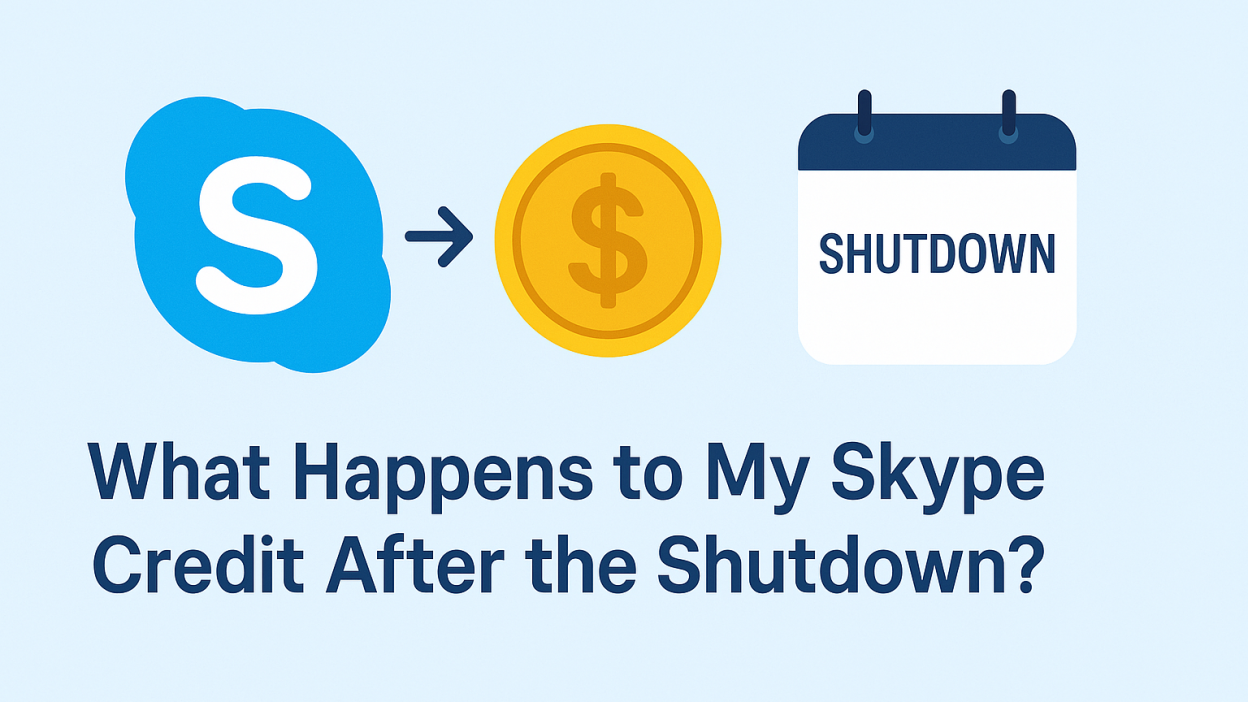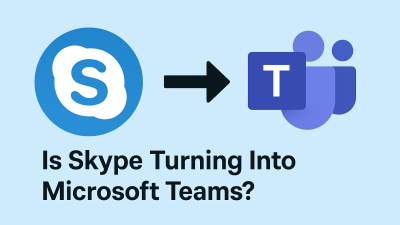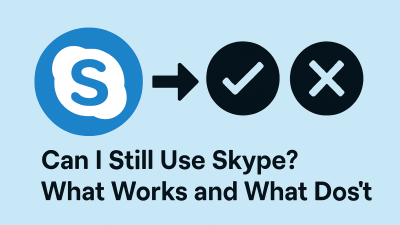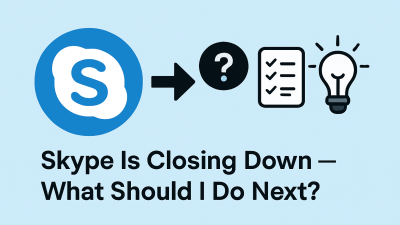You weren’t just using Skype for casual chats or quick check-ins. You paid for it. Whether it was a few dollars for Skype Credit to make international calls, a monthly plan to stay connected with family, or a Skype Number for freelance work, you handed over your card, got charged, and expected reliable service in return.
And now, with Skype shutting down on May 5, 2025, you’re left asking a very specific, very fair question:
What happens to the money I still have in my Skype account?
This post isn’t about explaining the shutdown itself. It’s not another blog repeating the same lines about Microsoft moving users to Teams. This is for you, the user who’s got a remaining balance, an active subscription, or a voice number tied to their digital life. It’s about what you still have access to, what you can expect to lose, and how to handle it with a clear head before the doors close.
This Isn’t Just Another App Sunset — Skype Credit Meant Something
For most people, app shutdowns are a mild inconvenience. Maybe a loss of convenience or habit. But when an app holds money, it changes everything. Skype wasn’t just a communication tool. It was how people connected across borders. It was how freelancers ran their businesses, how expats called home, how parents helped kids studying abroad.
And Skype Credit wasn’t an abstract token, it was money. Actual money that bought you minutes, calls, and access.
Some users only ever put in a few dollars at a time. Others kept a monthly budget to support regular communication across continents. Either way, it was a transaction built on trust: pay upfront, and Skype would deliver.
So when that platform starts winding down, and the features you paid for are on the way out, you have every right to demand clarity, not just vague support pages and transition language.
What’s Happening to Skype Credit After May 2025
Now let’s get practical. Here’s the current reality:
-
You can no longer buy Skype Credit. Microsoft stopped accepting new payments for credit, subscriptions, Skype Numbers, and paid features as part of the shutdown rollout.
-
Your existing credit is still active — but only if it was added before the cutoff date.
-
Your credit will not be deleted on May 5, but the platform you use to access it is changing.
-
Skype as a standalone app is going away. But Microsoft is offering a partial continuation through its other platform: Microsoft Teams (Free).
They’re not making this easy to navigate. There’s no banner that says “your credit moves here.” No big neon sign. But for users with remaining balances, Microsoft is offering a pathway, not permanent, but functional, through what’s called the Skype Dial Pad inside Teams.
That’s where you’ll need to go if you want to finish using what you paid for.
You Still Have Access — But the Door Is Narrowing
After Skype officially shuts down, you won’t open the Skype app and make a call the way you always did. The app will be phased out. Links will redirect. Some features will disappear entirely.
But if you had Skype Credit in your account, you won’t lose it, yet. Instead, that credit becomes accessible inside Microsoft Teams Free, where it functions much like it did in Skype, allowing international calls via a digital dial pad.
This isn’t a full migration. Your credit doesn’t get transferred into a Microsoft Wallet or merged with your other services. It remains isolated, usable only in one corner of Teams, and only for a limited time.
This is Microsoft’s quiet solution: they’re honoring the money you spent, but only within the ecosystem they’re moving toward. You won’t be able to use that credit for anything else, and once it’s gone, there’s no way to buy more.
Subscriptions, Skype Numbers, and Auto-Renewals — All of It Is Ending

For users who went beyond pay-as-you-go, the ones with Skype Numbers for client work, voicemail plans, or unlimited regional calling subscriptions, the transition is even sharper.
Microsoft has confirmed:
-
Skype Numbers will no longer be offered after the shutdown.
-
Monthly plans will not auto-renew.
-
All paid Skype subscriptions will expire at the end of their current billing cycle, no extensions, no carryovers into Teams.
-
You will not be able to reactivate any paid features, even if your plan ends a day before the shutdown.
In other words, if you had a calling subscription that renews monthly and your last renewal date is April 15, 2025, you’ll be able to use it until mid-May, but you won’t be charged again and you won’t be able to re-enroll after.
Microsoft isn’t transitioning these subscriptions into equivalent Teams services. Once they expire, they’re done.
This can feel like a cut-off that doesn’t match the investment, and for many users, it isn’t just about losing a tool. It’s about being locked out of a setup that worked perfectly, and having no real alternative within Microsoft’s current offering.
Why Skype Credit Isn’t Rolling Over — and What That Tells You About Microsoft’s Shift
There’s a reason your Skype Credit isn’t becoming Microsoft credit. There’s a reason your subscriptions aren’t transferring to Teams. It’s because Microsoft isn’t interested in replicating Skype’s à la carte communication model inside Teams.
Skype was a pay-what-you-need tool. Teams is a full-service platform meant for collaboration, mostly in business and education spaces. It has chat, meetings, communities, and integrations with Microsoft 365. But it doesn’t support flexible, low-cost international calling as a core feature. And it doesn’t plan to.
So this migration isn’t a 1:1 exchange. It’s a shift from a lightweight, user-friendly product to an enterprise-ready system, and personal users who used Skype for its affordability and simplicity are being asked to adapt or move on.
That’s not a decision you need to accept passively. You can still take steps to protect your balance, use what you’ve paid for, and find a replacement that respects your habits.
You Can Still Use Your Credit — But Only Through Teams (And Only If You Move Now)
After May 5, your Skype app will stop working, but your access to Skype Credit won’t vanish immediately.
If you log into Microsoft Teams Free using the same Microsoft account that holds your Skype balance, you’ll find the Skype Dial Pad — a quiet little feature built for this very moment. It’s where you’ll be able to:
-
Make international calls using your remaining credit
-
Track your balance as it ticks down
-
Finish using the credit you’ve already paid for
What you won’t be able to do:
-
Add more credit
-
Refill your balance
-
Convert your credit to Microsoft account funds
-
Use your credit for any other Microsoft service
That Dial Pad is your final destination for Skype Credit. It’s a soft landing, not a solution.
When the Credit Runs Out, There’s No Way Back In
By now, you know your Skype Credit doesn’t just disappear on May 5. If it’s already in your account, it stays available for a short while inside Microsoft Teams Free — accessible through the Skype Dial Pad.
But this continuation is limited.
Once you use up your remaining balance, you’re done. Microsoft has completely shut down Skype’s payment system, and that includes:
-
Recharging your Skype Credit
-
Reactivating old subscriptions
-
Buying a new Skype Number
-
Paying for long-distance bundles or voicemail
In short, there’s no more pay-as-you-go option inside Microsoft’s platform. When the balance hits zero, the system closes. Quietly. Permanently.
If Skype Credit was your lifeline, your affordable link to clients or loved ones abroad, this isn’t just the end of a service. It’s the end of a simple, trusted communication method, and Microsoft hasn’t offered a real replacement inside Teams.
The tools are different now. The expectations are different. And for many long-time users, Teams feels heavier, more complex, and not nearly as personal.
Can You Get a Refund for Unused Skype Credit? Sometimes — But Not Always
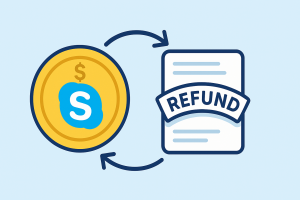
Refunds sound simple, until they’re not. Microsoft does offer a way to reclaim unused Skype Credit, but it’s not automatic. And depending on your situation, you may or may not qualify.
Let’s break it down.
You might be eligible for a refund if:
-
Your account is no longer accessible or active after the shutdown
-
You are unable to use Skype Credit inside Teams, even after following Microsoft’s transition instructions
-
You live in a region where local consumer protection laws require refunds for discontinued services
-
You have a remaining balance that you’ve made no attempt to use since the shutdown began
You likely won’t get a refund if:
-
You’ve already used most of your balance and simply changed your mind
-
You’re still able to access the Dial Pad in Teams but prefer not to use it
-
You miss the refund window Microsoft sets (they haven’t made this window public, but it will eventually close)
To request a refund:
-
Visit Microsoft Support and log in with your Skype account
-
Use the live chat or “Contact Us” form
-
Select Skype > Account & billing > Refund request
-
Provide the amount remaining and any payment confirmation if needed
-
Wait — responses can take a few business days
Microsoft has stated refunds will be returned to your original payment method. So if you used PayPal, a credit card, or another service, be sure it’s still active and able to receive funds.
This process isn’t well advertised — but it’s still available for users who take the time to ask. If you’re holding onto $10, $50, or more in unused credit, don’t wait too long. Once the Teams migration becomes final and support policies tighten, your window may close without warning.
Subscriptions and Skype Numbers: Why You Need a Plan Before They Expire
If you had a Skype Number, you were ahead of the curve — running your own virtual phone setup, possibly managing work calls or long-distance contacts like a pro.
But as of early 2025:
-
No new Skype Numbers can be purchased
-
Existing Skype Numbers will expire at the end of their current renewal period
-
Microsoft will not auto-renew these services anymore
-
There’s no replacement for Skype Numbers inside Teams
What this means practically is: if you’ve been using a Skype Number on your website, resume, business card, or job profile — you need to start updating it now. Because once that number expires, you won’t be able to recover it.
The same is true for unlimited calling subscriptions. Whether it was North America, India, Europe, or a global package, those plans will not renew, and you can’t re-purchase them after expiration.
There’s no direct Teams equivalent. Teams is built around internal calling, not pay-as-you-go voice minutes. If calling is a core part of your workflow, especially outbound calling to phones, not just other app users — you’ll need to look elsewhere.
So… Is Microsoft Teams Enough? It Depends on What You Need
If you’re reading this, chances are you didn’t use Skype because it was trendy or cutting-edge. You used it because it worked, and it was priced fairly.
So when Microsoft nudges you into Teams, it’s natural to ask:
Will this actually replace what I had with Skype?
Let’s be honest about what Teams is:
-
A powerful app for group collaboration
-
A central hub for meetings, chats, file sharing, calendars
-
Geared toward business, education, and enterprise users
And what it isn’t:
-
A lightweight, standalone calling app
-
Optimized for casual or personal international calling
-
Flexible for users who don’t want a Microsoft 365 ecosystem
If your primary use of Skype was for messaging family, making cheap international calls, or keeping a single line of communication open, Teams might feel like a strange, oversized tool. You don’t need channels and calendars. You just want to make a call without jumping through setup menus.
So no — for many personal users, Teams won’t fully replace Skype. Not in feel, not in cost, not in focus.
A Practical, Personal Alternative: What to Do if Skype Was Your Main Calling Tool
Here’s where the conversation becomes less about Microsoft and more about you.
If Skype Credit was your preferred way to make international calls, and you’re not interested in navigating Teams just to access a hidden dial pad, you have other options.
One of the most consistent replacements users have moved to is MyTello.
Why?
-
It’s simple. You sign up, add credit, and start calling.
-
It’s flexible. You can use any landline or mobile phone — no need to install an app on both ends.
-
It’s affordable. Rates are competitive with Skype’s old model, sometimes even better.
-
No long-term commitment. No contracts. No bundles. Just calling.
MyTello isn’t the only tool out there, but it’s one of the few that focuses on exactly what Skype Credit offered — straightforward, prepaid global calling that doesn’t require being part of a larger productivity platform.
If you’re not looking to juggle meeting invites and channel notifications just to make a call, MyTello (or a similar focused tool) might give you a cleaner, easier path forward.
Final Actions to Take Before It’s Too Late
If you haven’t already:
-
Log in to your Skype account and check your current balance
-
Decide whether you want to use that credit inside Teams or apply for a refund
-
If you had a Skype Number, replace it everywhere you’ve shared it — online and offline
-
Download any call history, receipts, or documents tied to your account
-
Look at replacement tools before you lose calling access
This isn’t just about tying up loose ends. It’s about recognizing that you were a paying customer, and you deserve to close out your experience with clarity, not confusion.
Goodbye, Skype Credit — and What Comes Next
This was more than just an app feature. Skype Credit made long-distance communication personal, affordable, and accessible. It bridged families, supported freelancers, and served millions quietly and consistently.
Now, as it fades out, you’re being asked to adapt, or find a new path.
If Microsoft Teams fits what you need, great. Use it to finish your balance, stay connected, and settle in.
If not? Take your business, your time, and your trust to a service that respects what you actually want, a clean, simple way to stay in touch with the people who matter most.
You’ve paid your part. Now, you deserve control over how it ends.

